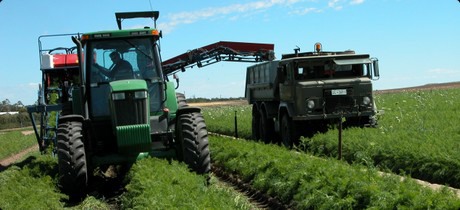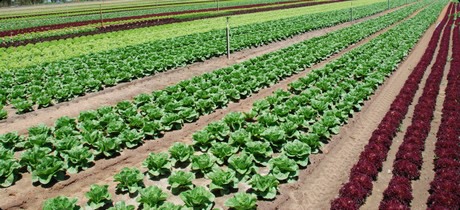Western Australia is an ideal location to grow vegetables as it has sophisticated production systems and an excellent environment for high quality produce. Production occurs throughout Western Australia, allowing a wide range of vegetables to be grown.
Major crops include carrots, potatoes, tomatoes and broccoli. The farm gate value of vegetable production in Western Australia in 2012 was $336 million while the retail value was close to $1 billion. The Department of Agriculture and Food works closely with industry and growers to promote growth in the vegetable industry.
A wide range of vegetables is grown commercially in Western Australia. Major crops include carrots, potatoes, tomatoes, capsicums, onions, broccoli, cauliflower and lettuce.
Other vegetables include pumpkin, sweet corn, zucchini, asparagus, beans, snow peas, cabbage, Asian vegetables, cucumbers, English spinach, sweet potato, spring onions, leeks, broccolini, swedes, turnips, beetroot and Brussels sprouts. Many other vegetables and herbs are also grown on a smaller scale.
The large geographic spread and range of production environments allows many vegetables to be grown year-round. Irrigation is used to ensure that crops are supplied with adequate water to produce high quality produce.

Production environment
Vegetables are produced throughout Western Australia from the tropical north near latitude 16°S to the temperate south of the state at 35°S. The main production region is the South West including the Swan Coastal Plain from Gingin (100km north of Perth) to Myalup (100km south of Perth).
The South West also includes production in the Pemberton, Manjimup and Albany areas. Heading north, vegetable production areas are located near Geraldton, Carnarvon, Broome and Kununurra.
Vegetables are grown from the very sandy soils of the coastal plain to loamy clay soils of the Manjimup and Pemberton regions to the river floodplains of the Carnarvon region.
Growers are fortunate that they do not have to manage many pests and diseases that impact on vegetable production in other places in the world. Vegetables in Western Australia are grown using modern integrated pest management (IPM) systems. There is also small-scale organic production.

Vegetable industry value
The farm gate value of vegetable production in Western Australia was $336 million in 2012. Carrots are a major export, with a total of $48 million worth exported to 15 countries in 2012.
Potatoes, for fresh, processing and seed markets, are also produced in large volumes, with sector farm gate values of $36 million, $12 million and $11 million respectively in 2013. The export market for certified seed potatoes is growing in countries including Indonesia, Thailand and Mauritius as well as interstate. Seed potato exports from Western Australia had a farm gate value of $3.8 million in 2012.
Most other vegetables are produced largely for the domestic market with some interstate sales mainly to New South Wales, Victoria and South Australia.
There is value-adding of some vegetables, in particular leafy greens such as lettuce, English spinach and baby leaf crops. These vegetables are often packed into mixed packs for the salad market or supplied to food processing companies for use in the catering and food service sectors.
Vegetable growers in Western Australia are highly experienced, with excellent knowledge of production methods and adherence to food safety standards.
They are guided by third party audited quality assurance schemes, ensuring that Western Australian vegetables are of high quality and safe to eat. Growers are highly aware of the environment and grow their crops to encompass environmental management methods.
DAFWA working with the vegetable industry
The Department of Agriculture and Food works closely with industry bodies including vegetablesWA (the Vegetable Growers Association), the Potato Growers Association and key growers to promote growth in the industry. Recent main areas of work have included:
- development of the seed potato industry
- reducing the amount of water required to produce vegetable crops through alternative irrigation systems
- promoting crop irrigation scheduling to increase water use efficiency
- integrated management programs for pests and diseases affecting vegetables
- increasing fertiliser use efficiency
- assisting industry to gain or regain market access to interstate and overseas markets.
Much of this work has been conducted as part of the development of good practice programs for vegetable crop production.
In collaboration with industry, the Department of Agriculture and Food recently updated the Good Practice Guide for vegetable production in Western Australia. This is available on the vegetablesWA website and includes information relevant for vegetables grown on soils other than the sands of the coastal plain.
Western Australia is an ideal location for vegetable production as it has sophisticated production systems using modern technology and an excellent environment for the production of high quality world class vegetables.
